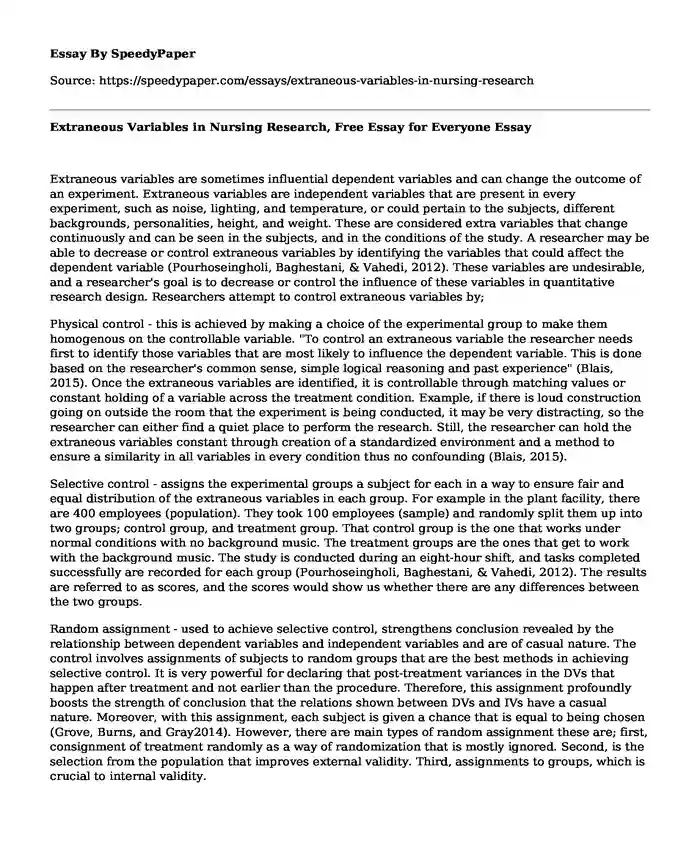Extraneous variables are sometimes influential dependent variables and can change the outcome of an experiment. Extraneous variables are independent variables that are present in every experiment, such as noise, lighting, and temperature, or could pertain to the subjects, different backgrounds, personalities, height, and weight. These are considered extra variables that change continuously and can be seen in the subjects, and in the conditions of the study. A researcher may be able to decrease or control extraneous variables by identifying the variables that could affect the dependent variable (Pourhoseingholi, Baghestani, & Vahedi, 2012). These variables are undesirable, and a researcher's goal is to decrease or control the influence of these variables in quantitative research design. Researchers attempt to control extraneous variables by;
Physical control - this is achieved by making a choice of the experimental group to make them homogenous on the controllable variable. "To control an extraneous variable the researcher needs first to identify those variables that are most likely to influence the dependent variable. This is done based on the researcher's common sense, simple logical reasoning and past experience" (Blais, 2015). Once the extraneous variables are identified, it is controllable through matching values or constant holding of a variable across the treatment condition. Example, if there is loud construction going on outside the room that the experiment is being conducted, it may be very distracting, so the researcher can either find a quiet place to perform the research. Still, the researcher can hold the extraneous variables constant through creation of a standardized environment and a method to ensure a similarity in all variables in every condition thus no confounding (Blais, 2015).
Selective control - assigns the experimental groups a subject for each in a way to ensure fair and equal distribution of the extraneous variables in each group. For example in the plant facility, there are 400 employees (population). They took 100 employees (sample) and randomly split them up into two groups; control group, and treatment group. That control group is the one that works under normal conditions with no background music. The treatment groups are the ones that get to work with the background music. The study is conducted during an eight-hour shift, and tasks completed successfully are recorded for each group (Pourhoseingholi, Baghestani, & Vahedi, 2012). The results are referred to as scores, and the scores would show us whether there are any differences between the two groups.
Random assignment - used to achieve selective control, strengthens conclusion revealed by the relationship between dependent variables and independent variables and are of casual nature. The control involves assignments of subjects to random groups that are the best methods in achieving selective control. It is very powerful for declaring that post-treatment variances in the DVs that happen after treatment and not earlier than the procedure. Therefore, this assignment profoundly boosts the strength of conclusion that the relations shown between DVs and IVs have a casual nature. Moreover, with this assignment, each subject is given a chance that is equal to being chosen (Grove, Burns, and Gray2014). However, there are main types of random assignment these are; first, consignment of treatment randomly as a way of randomization that is mostly ignored. Second, is the selection from the population that improves external validity. Third, assignments to groups, which is crucial to internal validity.
References
Blais, K. (2015). Professional nursing practice: Concepts and perspectives. Pearson.
Grove, S. K., Burns, N., & Gray, J. (2014). Understanding nursing research: Building an evidence-based practice. Elsevier Health Sciences.
Pourhoseingholi, M. A., Baghestani, A. R., & Vahedi, M. (2012). How to control confounding effects by statistical analysis. Gastroenterology and Hepatology from bed to bench, 5(2), 79.
Cite this page
Extraneous Variables in Nursing Research, Free Essay for Everyone. (2022, Mar 25). Retrieved from https://speedypaper.net/essays/extraneous-variables-in-nursing-research
Request Removal
If you are the original author of this essay and no longer wish to have it published on the SpeedyPaper website, please click below to request its removal:
- Personal Moral Philosophy, Essay Sample
- Law Essay Sample on Child's Custody Doctrines
- Essay Sample Comparing Healthcare Systems of US and Great Britain
- Free Essay: Dual Diagnosis and Psychopharmacology
- Marketing Essay Example: Andy's Body Lotion Targeting
- Free Essay Comparing and Contrasting the Stoic, Buddhist, and Modern Psychological Perspectives
- Free Essay: Differences Between WW I and WW II
Popular categories





